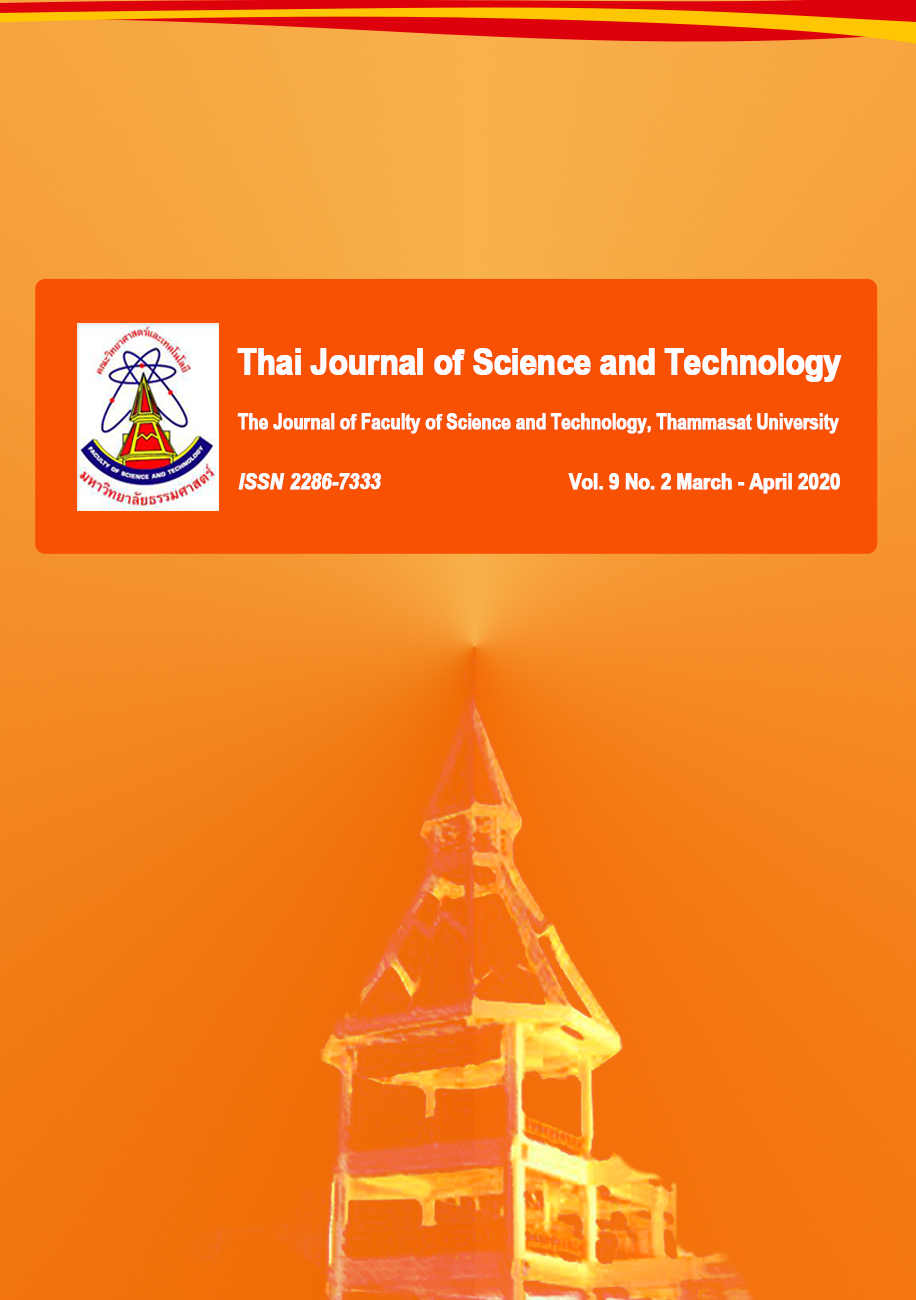การปรับปรุงพันธุ์เพื่อเพิ่มสารแอนโทไซยานินในเมล็ดข้าวโพดหวานลูกผสม
Main Article Content
บทคัดย่อ
ยีนที่ความคุมลักษณะความหวาน (shrunken-2, sh2sh2) ยีนควบคุมลักษณะสีม่วง (purple, Pr1Pr1) และยีนที่ทำให้เกิดสี (color, C1C1) ในข้าวโพดอยู่บนโครโมโซมที่ 3, 5 และ 9 ตามลำดับ ถ้า 3 ยีน รวมอยู่ในข้าวโพดพันธุ์เดียวกัน และการแสดงออกของแต่ละยีนเป็นปกติจะก่อให้เกิดสารแอนโทไซยานินเพิ่มขึ้นที่เปลือกหุ้มเมล็ดข้าวโพดหวาน ซึ่งเป็นประโยชน์ต่อสุขภาพของผู้บริโภค การทดลองนี้มีวัตถุประสงค์เพื่อรวมยีนควบคุมลักษณะสีม่วงจากข้าวโพดข้าวเหนียวโอเปกทูสีม่วงมาไว้ในข้าวโพดหวาน โดยการผสมพันธุ์ระหว่างข้าวโพดข้าวเหนียวสีม่วงกับสายพันธุ์แท้ข้าวโพดหวานได้ลูกผสมชั่วที่ 1 (F1) จากสายพันธุ์ผสมตัวเองชั่วที่ 2 (S2) คัดเลือกเฉพาะเมล็ดเหี่ยวย่น (wrinkle) ที่มีสีม่วงหรือสีแดงเพื่อนำไปปลูกและผสมตัวเองเป็นสายพันธุ์ข้าวโพดหวานชั่วที่ 3 (S3) จากนั้นคัดเลือกเฉพาะสายพันธุ์ที่มีเมล็ดสีม่วงผสมตัวเองต่อเนื่องจนถึงชั่วที่ 6 (S6) แล้วคัดเลือก 9 สายพันธุ์ มาผสมพันธุ์แบบทอปครอส (topcross) โดยใช้พันธุ์แม่ 8 สายพันธุ์ และพันธุ์พ่อ 1 สายพันธุ์ ได้ลูกผสมเดี่ยว 8 คู่ผสม ผลการทดสอบผลผลิตลูกผสมพบว่าเมล็ดลูกผสมทดสอบมีปริมาณน้ำตาลทั้งหมด (182-460 mg/g) น้ำตาลนอนรีดิวซ์ (174-451 mg/g) และปริมาณสารแอนโทไซยานิน (131-141 mg/100g) ในเมล็ดสูง ทุกคู่ผสมมีเมล็ดสีม่วงและมีคุณภาพการรับประทานดี นอกจากนี้สารแอนโทไซยานินในเมล็ดลูกผสมทดสอบมีปริมาณสูงกว่าข้าวโพดหวานพันธุ์ร่วมทดสอบทั้งเมล็ดสีม่วง (71 mg/100 g) และเมล็ดสีเหลือง (5 mg/100 g) คู่ผสม Ag-PS3 x Ag-PS9 และ Ag-PS7 x Ag-PS9 มีน้ำหนักฝักสด ปริมาณน้ำตาลทั้งหมด และน้ำตาลนอนรีดิวซ์ ในระดับเดียวกับพันธุ์ลูกผสมร่วมทดสอบ คือ พันธุ์อินทรี 2 และพันธุ์ PAC12081A โดยสรุปแล้วการรวม 2 ลักษณะทางคุณภาพของเมล็ด คือ สีม่วงของเปลือกหุ้มเมล็ด (Pr1Pr1C1C1) กับความหวานในเมล็ด (sh2sh2) เป็นข้าวโพดหวานสีม่วงประสบความสำเร็จทั้งในสายพันธุ์แท้และลูกผสมเดี่ยว ซึ่งสามารถเพิ่มคุณค่าทางอาหารของข้าวโพดหวาน
Article Details
บทความที่ได้รับการตีพิมพ์เป็นลิขสิทธิ์ของคณะวิทยาศาสตร์และเทคโนโลยี มหาวิทยาลัยธรรมศาสตร์ ข้อความที่ปรากฏในแต่ละเรื่องของวารสารเล่มนี้เป็นเพียงความเห็นส่วนตัวของผู้เขียน ไม่มีความเกี่ยวข้องกับคณะวิทยาศาสตร์และเทคโนโลยี หรือคณาจารย์ท่านอื่นในมหาวิทยาลัยธรรมศาสตร์ ผู้เขียนต้องยืนยันว่าความรับผิดชอบต่อทุกข้อความที่นำเสนอไว้ในบทความของตน หากมีข้อผิดพลาดหรือความไม่ถูกต้องใด ๆ
เอกสารอ้างอิง
Abe, A., Lasisi, O.A. and Akinrinbola, O.J., 2019. Field performance of shrunken-2 super-sweet corn populations derived from tropical field maize x shrunken-2 super-sweet corn crosses in Ibadan, Nigeria, J. Plant Breed. Crop Sci. 11: 158-163.
Brewbaker, J.L. and Martin, I., 2015, Breeding tropical vegetable corns, Plant Breed. Rev. 39: 125-198.
Castaneda-Ovando, A., Pacheco-Hernandez, M.L., Paez-Hernandez, M.E., Rodriguez, J.A. and Galan-Vidal, C.A., 2009, Chemical studies of anthocyanins: A review, Food Chem. 113: 859-871.
Cevallos-Casals, B.A. and Cisneros-Zevallos, L., 2003, Stoichiometric and kinetic studies of phenolic antioxidants from Andean purple corn and red-fleshed sweetpotato, J. Agric. Food Chem. 51: 3313-3319.
Creech, R.G., 1965, Genetic control of carbohydrate synthesis in maize, Genetics 52: 1175-1186.
Evensen, K.B. and Boyer, C.D., 1986, Carbohydrate composition and sensory quality of fresh and stored sweet corn, J. Am. Soc. Hort. Sci. 111: 734-738.
Galicia, L., Nurit, E., Rosales, A. and Palacios, R.N., 2008, Laboratory Protocols 2009: Maize Nutritional Quality and Plant Tissue Analysis Laboratory, CIMMYT, Mexico D.F.
Garwood, D.L., McArdle, F.J., Vanderslice, S.F. and Shannon, J.C., 1976, Postharvest carbohydrate transformations and processed quality of high sugar maize in genotypes, J. Am. Soc. Hort. Sci. 101: 400-404.
Hannah, L.C., 2005, Starch synthesis in maize endosperm, Maydica 50: 497-506.
Jing, P. and Giusti, M.M., 2005, Characterization of purple corncobs (Zea mays L.) anthocyanin-rice waste and its application in dairy products, J. Agric. Food Chem. 53: 8775-8781.
Li, J., Walker, C.E. and Faubion, J.M., 2011, Acidulant and oven type affect total anthocyanin content of blue corn cookies, J. Sci. Food Agric. 91: 38-43.
Nelson, O.E., Mertz, E.T. and Bates, L.S., 1979, Inheritance of amino acid content in cereals: Seed protein improvement in cereal and grain legumes, Science 145: 279-280.
R Core Team, 2019, R: A language and environment for statistical computing, R Foundation for Statistical Computing, Vienna, Austria, Available Source: http://www.R-project.org, August 8, 2019.
Rosemary, H.F., 2000, Inheritance of kernel color in corn: Explanations & investigations, Am. Biol. Teach. 62: 181-188.
Sharma, M., Cortes-Cruz, M., Ahern, K.R., McMullen, M., Brutnell, P.T. and Chopra. S., 2011, Identification of the Pr1 gene product completes the anthocyanin biosynthesis pathway of maize, Genetics 188: 69-79.
Soberalske, R.M. and Andrew, R.H., 1978, Gene effects kernel moisture and sugars of near-isogenic lines of sweet corn, Crop Sci. 18: 743-746.
Thevenot, D., Delignette-Muller, M.L., Chris tieans, S. and Vernozy-Rozand, C., 2005, Prevalence of Listeria monocytogenes in 13 dried sausage processing plants and their products, Int. J. Food Microbiol. 102: 85-94.
Tracy, W.F., 2001, Sweet Corn, pp. 155-197, In Hallauer, A.R. (Ed.), Specialty Corns, CRC Press, Boca Raton, FL.
Wong, A.D, Juvik, J.A., Breeden, D.C. and Swiader, J.M., 1994, Shrunken2 sweet corn yield and the chemical components of quality, J. Am. Soc. Hort. Sci. 119: 747-755.
Zhao, X., Zhang, C., Guigas, C., Ma, Y., Corrales, M., Hu, X. and Tauscher, B., 2008, Composition and thermal stability of anthocyanins from Chinese purple corn (Zea mays L.), J. Agric. Food Chem. 56: 20761-10766.


